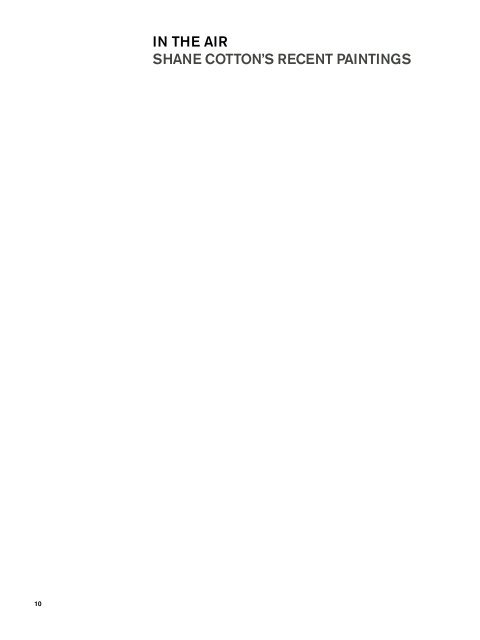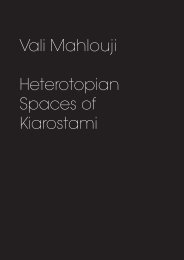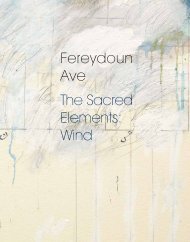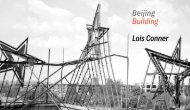Shane Cotton To and Fro
Untitled - Rossi & Rossi
Untitled - Rossi & Rossi
- No tags were found...
Create successful ePaper yourself
Turn your PDF publications into a flip-book with our unique Google optimized e-Paper software.
in the air<br />
<strong>Shane</strong> cotton’s recent paintings<br />
1<br />
The earliest painters of the New Zeal<strong>and</strong> l<strong>and</strong>scape seldom took the<br />
opportunity to look up. Along with the farmers, surveyors <strong>and</strong> other<br />
colonists who came to the country in the mid-nineteenth century, their<br />
gazes were fixed on the real estate below rather than the open space<br />
above. After all, in a settler culture success belonged to those who had<br />
their ‘feet on the ground’ <strong>and</strong> the means to work that piece of terrain. This<br />
preference for the earthbound over the atmospheric persists today in both<br />
art <strong>and</strong> life. Spend too much time gazing skyward <strong>and</strong> you’ll find yourself<br />
pegged as a dreamer, a duffer, someone with their ‘head in the clouds’.<br />
The common injunction to ‘keep your head down’ is more than just an<br />
attitude to work. It’s an attitude to life, a world-view. Even today l<strong>and</strong>scape<br />
painting tends to focus on l<strong>and</strong> more than sky.<br />
But there are exceptions to this rule. Internationally, there is Vija Celmins<br />
with her densely worked night skies; <strong>and</strong> in New Zeal<strong>and</strong>, there is <strong>Shane</strong><br />
<strong>Cotton</strong>. Over the last five years, this artist has presented an exhilarating<br />
argument for the importance of looking up. Throughout the 1990s<br />
<strong>Cotton</strong> painted a world with stable horizons, where sepia-toned slices<br />
of hill <strong>and</strong> coastline were carefully stacked like samples in a cabinet of<br />
curiosity. Nothing in these acclaimed early paintings prepared a viewer<br />
for paintings like Red Shift or Lookout 1 from 2007, which perform the<br />
painterly equivalent of dropping the viewer off a cliff. Rock faces rush<br />
past uncomfortably close, their surfaces stretched by the speed of the<br />
descent. Birds fly through the air, buffeted <strong>and</strong> oddly flattened by unseen<br />
crosswinds. And always, beyond the l<strong>and</strong>forms, there are skies – blueblack<br />
voids that seem deeper, higher <strong>and</strong> darker than an ordinary night. It<br />
is as if, after a decade spent patiently sampling <strong>and</strong> ordering pieces of the<br />
post-colonial l<strong>and</strong>scape, <strong>Cotton</strong> wanted to punch out <strong>and</strong> through to a new<br />
l<strong>and</strong>scape space where the old sense of gravity no longer prevailed.<br />
There are six major canvases in progress when I visit <strong>Cotton</strong> early in 2010,<br />
<strong>and</strong> sky is everywhere in them. It’s our habit to talk about sky as ‘negative<br />
space’, a formless background defined in relation to the ‘positive’ forms of<br />
l<strong>and</strong> <strong>and</strong> buildings. But the skies that fill these new paintings are anything but<br />
formless or diffused. The point of view is low, raised just above the horizon,<br />
<strong>and</strong> from here cloud rises up dramatically – from low wide b<strong>and</strong>s through<br />
thick pilings <strong>and</strong> further up into thinly raked cirrus. The bellies of the clouds<br />
are black, as if dense with stormy energy, <strong>and</strong> light simmers on their edges.<br />
The effect suggests the nineteenth-century productions of a painter like<br />
John Martin (1789-1854), who remade the sky as a religious theatre where<br />
God declared his glory or wrath. With <strong>Cotton</strong>’s paintings, however, we’re left<br />
unsure who exactly controls the skies. The absence of colour quietens <strong>and</strong><br />
estranges the scenes – as if we’re seeing a romantic nineteenth-century<br />
cloudscape through a twenty-first century filter. The light that remains has the<br />
strangeness of a full eclipse, when it is day <strong>and</strong> night simultaneously. Perhaps<br />
the light is about to go out, or perhaps it’s about to break through. Either way,<br />
there’s no mistaking the atmosphere of suspense: these skies feel tense,<br />
crackling, primed. Something is about to happen.<br />
10 11











